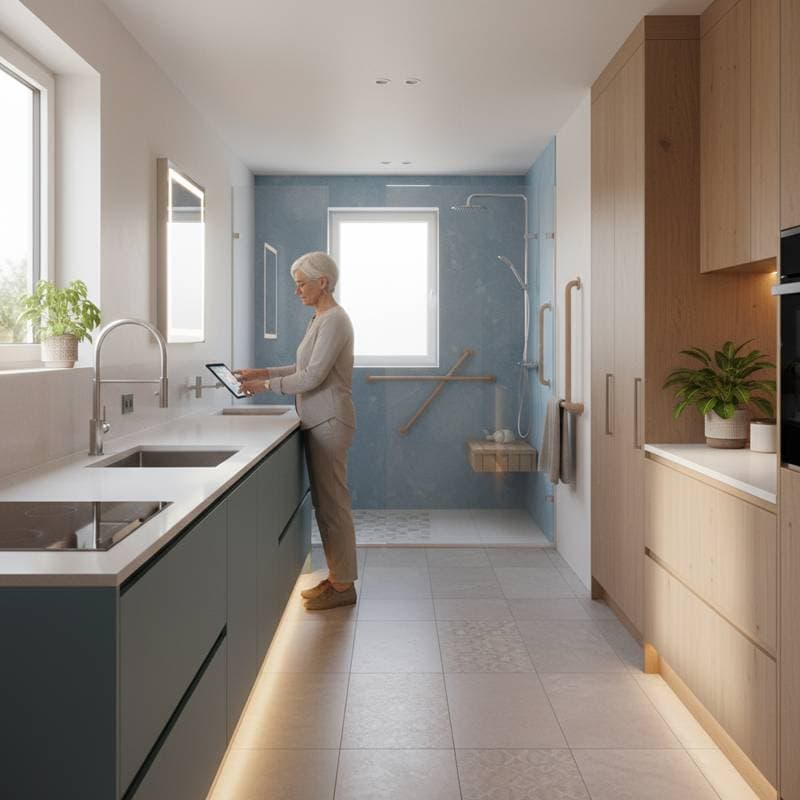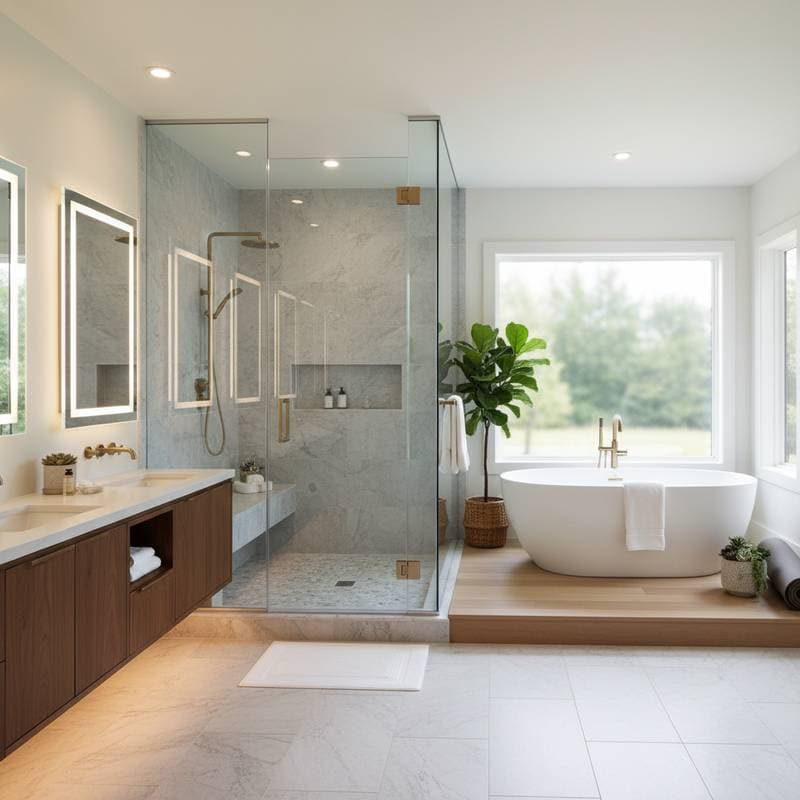The Real Costs of Aging-in-Place Bathroom Remodels
Designing a bathroom that supports aging-in-place goals proves both practical and rewarding. Such a remodel promotes safety, comfort, and independence at home. It also enhances property value and functionality. Costs vary based on materials, layout changes, and accessibility needs. This guide details expected expenses to aid confident planning and informed decisions.
Understanding the Purpose Behind Aging-in-Place Design
Aging-in-place bathroom remodels emphasize safety, accessibility, and enduring usability. These designs minimize risks like slips, strained movements, or hard-to-reach elements. They also simplify maintenance.
Essential features include:
- Zero-threshold showers that allow seamless entry
- Grab bars paired with reinforced walls for reliable support
- Non-slip flooring to minimize fall risks
- Wider doorways compatible with mobility aids
- Comfort-height toilets that ease use
- Targeted lighting that reduces glare
These elements boost safety and ease. Expenses hinge on remodel scope and whether adjustments involve existing structures or new builds.
The Range of Costs at a Glance
Aging-in-place projects span simple enhancements to complete overhauls. Typical ranges include:
-
Basic Safety Upgrades – Additions like grab bars, handheld showerheads, and enhanced lighting. These require minimal disruption and stay within $1,000 to $3,000, avoiding major plumbing or structural work.
-
Mid-Level Remodels – Updates such as converting a tub to a walk-in shower, adding slip-resistant flooring, and installing comfort-height fixtures. Expect $5,000 to $12,000, factoring in labor and materials.
-
Full Accessibility Renovations – Comprehensive changes like layout reconfiguration for wheelchair maneuverability, doorway expansions, and custom cabinetry with roll-under sinks. Budget $15,000 to $30,000 or more, due to plumbing, electrical, and structural modifications that ensure lasting benefits.
Key Cost Factors to Consider
Each bathroom project differs. Several factors shape the overall expense of an aging-in-place renovation.
1. Size and Layout
Compact bathrooms restrict fixture rearrangements, while spacious ones offer greater adaptability. Extending a bathroom for better mobility involves framing, additional flooring, and plumbing shifts, potentially adding $2,000 to $5,000.
2. Plumbing and Electrical Adjustments
Relocating a shower or toilet demands pipe and drain rerouting, often costing $1,500 to $4,000. Electrical upgrades for improved lighting or heated floors enhance safety and warmth but necessitate licensed experts, with fees from $800 to $2,500.
3. Material Selection
Opt for resilient, easy-care options that cost more initially yet lower future upkeep. Porcelain tiles with matte finishes provide grip and durability at $5 to $15 per square foot. Solid-surface countertops and shower surrounds ward off moisture and simplify cleaning, priced at $50 to $100 per square foot.
4. Custom Accessibility Features
Tailored elements like built-in benches, roll-in showers, or adjustable sinks elevate costs by $1,000 to $3,000 each. Prefabricated shower bases cut expenses to $800 to $2,000 while delivering core safety.
5. Professional Labor
Skilled contractors handle waterproofing, tiling, and fixture placement correctly. Accessibility projects coordinate carpenters, plumbers, electricians, and tilers, with labor accounting for 40 to 60 percent of total costs, or $50 to $150 per hour.
Common Aging-in-Place Upgrades and Their Purpose
Consider these impactful upgrades, their benefits, and implementation details.
-
Zero-Threshold Shower
Seamless entry eliminates step-over barriers, lowering fall chances and suiting walkers or wheelchairs. Integrate a linear drain for efficient drainage and textured tiles for traction; installation runs $3,000 to $7,000. -
Grab Bars and Reinforced Walls
Position bars by showers and toilets for secure holds. Bolster walls with plywood backing to bear up to 250 pounds. Select brushed nickel or chrome finishes to blend with hardware; costs range from $200 to $800 per set. -
Slip-Resistant Flooring
Choose textured porcelain, luxury vinyl planks, or rubber mats for superior grip. Light hues amplify illumination and aid visibility. Replacement expenses fall between $4 to $12 per square foot, including installation. -
Comfort-Height Toilet
Elevated models at 17 to 19 inches reduce joint stress. Add a soft-close lid and adjacent grab bar for added ease. Units cost $300 to $800, with installation at $200 to $500. -
Adjustable Showerheads and Seating
Handheld units offer versatile rinsing, while fold-down benches provide rest. Mount at 48 to 54 inches for accessibility; combined setups price at $150 to $600. -
Improved Lighting
Combine recessed ceiling lights, sconces by mirrors, and low-level path illumination. Warm LED bulbs prevent harsh shadows; total setup costs $300 to $1,000. -
Wider Doorways and Open Layouts
Widen openings to 32 to 36 inches for aid passage. Install pocket or barn doors to conserve space; modifications add $500 to $2,000.
Balancing Costs and Long-Term Value
Upfront investments may appear steep, yet they avert expenses from injuries or relocation needs. Durable selections and neutral aesthetics extend the remodel's lifespan.
Integrate universal design with contemporary touches, such as clear glass enclosures over linear drains or matte black fixtures against white tiles. Consult specialists in accessible builds to allocate funds wisely. For example, embed wall blocking for potential grab bars during initial phases at under $500.
Budgeting Tips for an Accessible Remodel
Maximize value with these strategies:
- Prioritize Safety Essentials. Focus first on anti-slip surfaces and support features to address immediate risks.
- Anticipate Evolving Needs. Select modular items like detachable seats or height-adjustable counters for adaptability.
- Invest in Lasting Materials. Allocate 20 to 30 percent more for quality to cut ongoing repairs.
- Solicit Multiple Bids. Obtain three to five quotes from certified pros versed in ADA guidelines.
- Explore Funding Options. Inquire about home modification grants, tax credits, or low-interest loans for accessibility.
Deciding Between DIY and Professional Help
Tackle minor tasks like affixing grab bars or swapping showerheads yourself, if equipped with tools and knowledge, saving $100 to $500. Delegate intricate elements—waterproofing, subflooring, or pipe work—to experts to comply with codes and avoid hazards.
Professionals deliver code-compliant results and refined aesthetics, safeguarding health and home equity.
Long-Term Benefits of an Aging-in-Place Bathroom
An accessible setup fosters autonomy and eases routines for extended periods. It demands less physical effort and instills security.
Universal principles extend utility to visitors with short-term limitations, creating inclusive spaces without aesthetic trade-offs.
Maintaining Your Investment
Low-maintenance choices simplify upkeep. Seal grout annually, wipe glass enclosures weekly, and check supports quarterly for firmness.
Adapt as circumstances shift by incorporating modular accessories or light enhancements. This approach ensures ongoing relevance and efficiency.
Thoughtful planning aligns budget with priorities and selects resilient components. The result: a bathroom that upholds graceful aging-in-place through enhanced safety, self-reliance, and well-being.










